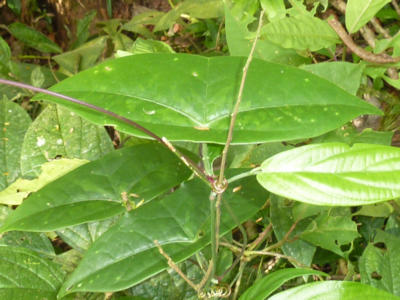Passiflora megacoriacea
P. megacoriacea is not common at La Selva, and is found mainly in shady older second growth areas and on the edges of clearings. Many plants are found near the banks of the rivers. The leaves of this species are unusually shaped, are thick, peltate and seemingly entire with "drip tips", like P. ambigua and P. pittieri. Like P. biflora, the relatively small flowers and fruits are together in pairs along the stem. Range: Widespead in Costa Rica below 1100 meters elevation, in wet and moist forest edges; also in Panama and NW Colombia. Only recently separated from its sibling species P. coriacea, which is found south to Bolivia. These species are members of section Cieca, subgenus Decaloba, with 17 species mainly in northern mesoamerica and the Caribbean.
P. megacoriacea foliage is slightly to moderately cyanogenic when crushed (.02 to 2.0 μM HCN per gram of plant tissue). The rate at which HCN is released from crushed leaves is about eight times slower than that of other La Selva Passiflora, taking over 2 hours instead of 15 minutes to release 99% of the gas. This could possibly deter herbivory by reducing the HCN "footprint" for searching female Heliconius while retaining toxicity in the herbivore gut. P. coriacea (probably including P. megacoriacea) contains the simple monoglycoside cyclopentyl cyanogens Volkenin and Epivolkenin, the complex diglycoside cyclopentyl Passisuberosin and Epipassisuberosin, and one of the aliphatic cyanogens (Engler 1998; Spencer 1988). Perhaps the slow release results from interference between the beta glucosidase enzymes specific to these various cyanogenic glycosides, as proposed in Spencer (1988). Examples of P. megacoriacea cyanogenesis may be seen in Appendix 2, charts A11, A12, A13, A14, A15, A16, and A17.
H. cydno and rarely H. erato lay their eggs on P. megacoriacea at La Selva, the former species on the tendril tips and the latter laying her eggs on the shoot tips among the incipient leaves. The growing shoots of this species are not as easily seen as those of most Passiflora species (see photo below). The unusual central petiole attachment breaks up the normal vine appearance, and the leaves seem to "float" unattached to any stem. This may help protect the plant from Heliconius oviposition.
I have not yet observed any flea beetles feeding on this species. I have seen some probable flea beetle feeding damage, so there may be some low level of herbivory. Could the lack of flea beetle herbivory somehow be related to the unusually slow release of HCN?


Note the "bat shaped" leaves. Does this shape make it difficult for herbivores to find the plants?

Enlarge this photo and you can see the large
petiolar nectaries, attractive to ants.